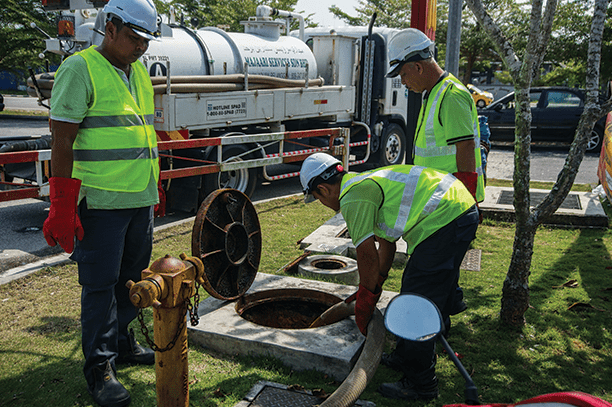What is a Septic System?
A septic system is a wastewater treatment system for those homeowners who do not have access to the public sewer system and prefer a private sewer system. Natural bacteria in the septic system break down the organic matter so that it can safely decompose in the field. Go through the article to know more about septic system components and their mechanism to understand how frequently they need to be pumped and cleaned.
How does it work?
- First of all, the wastewater coming from the house moves to the septic tank,
- The septic tank is a buried, watertight container generally made of concrete, polyethylene, or fiberglass. The compartments and the t-shaped outlet prevent the scum and sludge from leaving the tank and traveling into the drain field.
- The soak away is a covered, shallow excavation made in unsaturated soil. If it is overloaded with liquid, then there are chances it will flood and cause sewage flow to the ground surface or create backups in sinks and toilets.
Know The Parts Of A Septic System
A residential septic system is a huge responsibility, and the complexities can overwhelm homeowners. It is important to understand the parts of the septic and how they work so that maintenance is easier. Here are the parts of a septic tank you must know about:
1. Septic Tank
The house septic tank is a watertight concrete, polyethylene, or fiberglass container. It is specifically designed to hold the waste generated by the household. It is a structure in which natural bacterial action breaks down solid organic particles.
2. Inlet, outlet, and center baffles
The inlet outlet is the entry pipe to the basic septic system, which connects the septic tank to the existing main pipe of the home. The inlet baffle helps slow the waste’s flow so the solids can settle to the bottom. The outlet baffle tee is the pipe that allows the wastewater to flow into the drainfield. It also keeps solids from exiting the tank, where they can damage the secondary components of the septic system.
3. Effluent filter
This filter will prevent solid waste and debris from entering the secondary treatment. You can also find them installed on the outlet baffle.
The waste formed inside the septic tank can be separated into three layers:
- Scum layer
It is the top layer in the tank, made up of oils, soaps, and fats. The scum layer is usually the first and foremost thing you may see floating at the top when you open the tank.
- Liquid layer
The middle layer comprises the remaining water after the sludge and scum have separated.
- Sludge layer
It contains heavier solids which are present on the bottom of the tank. It is where the decomposition procedure continues using bacteriological interaction.
4. Outlet pipe
It carries the liquid effluent to the seepage field.
5. Pumping cover
It provides access to the septic tank for cleaning.
6. Seepage field
It is also called the drain field or the leach field, which is the series of perforated pipes and tiles set in the gravel and slanted away from the home. A seepage field is buried below the soil’s frost level, so there is no chance of freezing.
7. Sewer line
It carries the wastewater from the home’s main drain to the septic tank. Local plumbing codes determine the minimum distance from the house to the tank as well as the depth of the entire system.
How to Maintain Your Septic System?
Maintaining your septic system is important to ensure it functions properly and efficiently and to prevent costly repairs and potential health hazards. Here are some tips for maintaining your septic system:
- Regularly pump the tank: The septic tank should be pumped and inspected by a professional every 3-5 years, depending on the size of the tank and the number of people using it.
- Conserve water: Excessive water usage can overload the system and reduce its effectiveness. You can conserve water by using water-efficient appliances, fixing leaks, and reducing water usage habits.
- Properly dispose of waste: Only flush human waste and toilet paper down the toilet. Avoid flushing other materials, such as paper towels, feminine hygiene products, or chemicals, as they can clog the system and cause damage.
- Protect the drainfield: Do not park or drive on the drainfield, as it can compact the soil and damage the pipes. Also, avoid planting trees and shrubs with deep roots in the drainfield area.
- Use septic-safe products: Avoid using harsh chemicals, antibacterial soaps, and other products that can disrupt the natural treatment process and kill the beneficial bacteria that break down waste.
- Inspect the system: Look for signs of problems such as slow-draining sinks or toilets, foul odors, or sewage backups. These could indicate a problem with the septic system and should be addressed immediately.
Contact American On-Site Septic
A septic tank can help you remove and treat the wastewater in your home. However, you must have an idea about the parts and mechanism of the septic system so that if any problem arises, you can solve it beforehand. American On-Site Septic provides septic tank pumping, cleaning, & maintenance in Wilsonville, Molalla, Sherwood and nearby areas. Contact us today for the septic tank solution.






